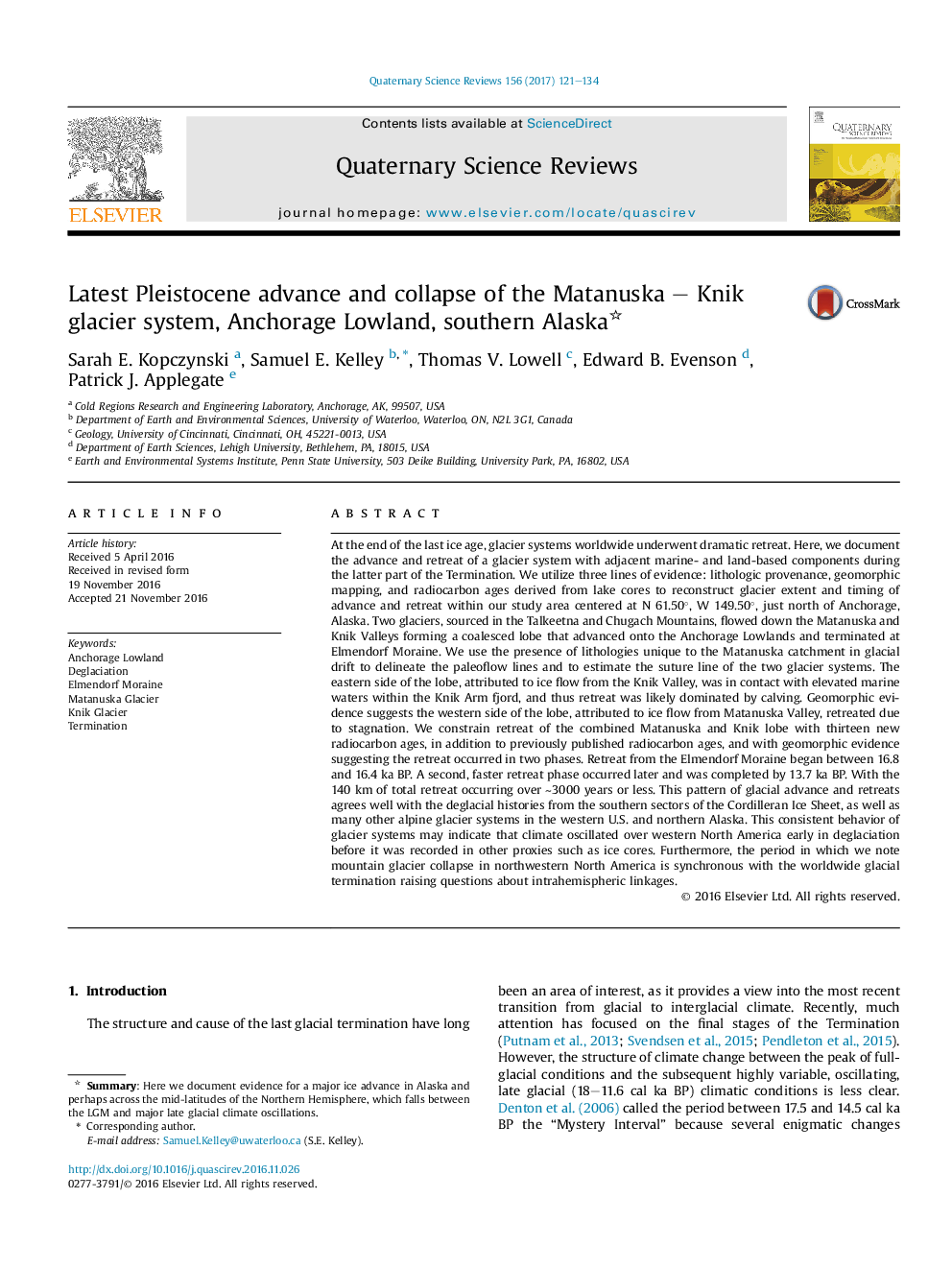| کد مقاله | کد نشریه | سال انتشار | مقاله انگلیسی | نسخه تمام متن |
|---|---|---|---|---|
| 5786792 | 1640779 | 2017 | 14 صفحه PDF | دانلود رایگان |
عنوان انگلیسی مقاله ISI
Latest Pleistocene advance and collapse of the Matanuska - Knik glacier system, Anchorage Lowland, southern Alaska
دانلود مقاله + سفارش ترجمه
دانلود مقاله ISI انگلیسی
رایگان برای ایرانیان
کلمات کلیدی
موضوعات مرتبط
مهندسی و علوم پایه
علوم زمین و سیارات
زمین شناسی
پیش نمایش صفحه اول مقاله

چکیده انگلیسی
At the end of the last ice age, glacier systems worldwide underwent dramatic retreat. Here, we document the advance and retreat of a glacier system with adjacent marine- and land-based components during the latter part of the Termination. We utilize three lines of evidence: lithologic provenance, geomorphic mapping, and radiocarbon ages derived from lake cores to reconstruct glacier extent and timing of advance and retreat within our study area centered at N 61.50°, W 149.50°, just north of Anchorage, Alaska. Two glaciers, sourced in the Talkeetna and Chugach Mountains, flowed down the Matanuska and Knik Valleys forming a coalesced lobe that advanced onto the Anchorage Lowlands and terminated at Elmendorf Moraine. We use the presence of lithologies unique to the Matanuska catchment in glacial drift to delineate the paleoflow lines and to estimate the suture line of the two glacier systems. The eastern side of the lobe, attributed to ice flow from the Knik Valley, was in contact with elevated marine waters within the Knik Arm fjord, and thus retreat was likely dominated by calving. Geomorphic evidence suggests the western side of the lobe, attributed to ice flow from Matanuska Valley, retreated due to stagnation. We constrain retreat of the combined Matanuska and Knik lobe with thirteen new radiocarbon ages, in addition to previously published radiocarbon ages, and with geomorphic evidence suggesting the retreat occurred in two phases. Retreat from the Elmendorf Moraine began between 16.8 and 16.4 ka BP. A second, faster retreat phase occurred later and was completed by 13.7 ka BP. With the 140 km of total retreat occurring over â¼3000 years or less. This pattern of glacial advance and retreats agrees well with the deglacial histories from the southern sectors of the Cordilleran Ice Sheet, as well as many other alpine glacier systems in the western U.S. and northern Alaska. This consistent behavior of glacier systems may indicate that climate oscillated over western North America early in deglaciation before it was recorded in other proxies such as ice cores. Furthermore, the period in which we note mountain glacier collapse in northwestern North America is synchronous with the worldwide glacial termination raising questions about intrahemispheric linkages.
ناشر
Database: Elsevier - ScienceDirect (ساینس دایرکت)
Journal: Quaternary Science Reviews - Volume 156, 15 January 2017, Pages 121-134
Journal: Quaternary Science Reviews - Volume 156, 15 January 2017, Pages 121-134
نویسندگان
Sarah E. Kopczynski, Samuel E. Kelley, Thomas V. Lowell, Edward B. Evenson, Patrick J. Applegate,